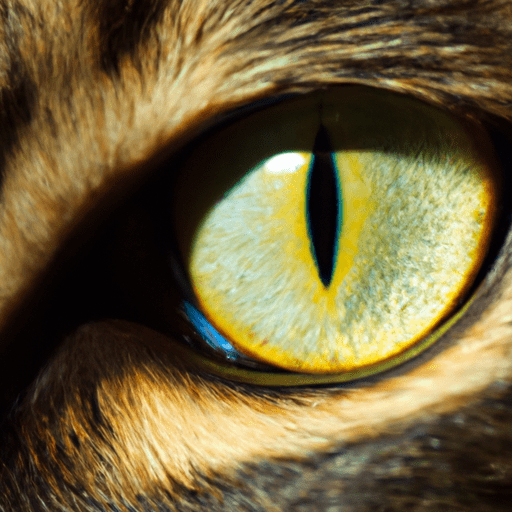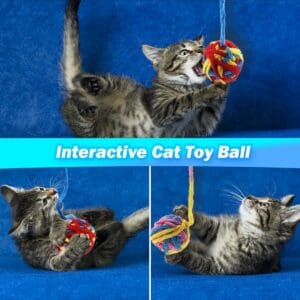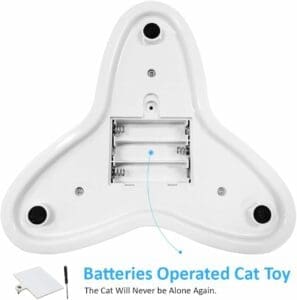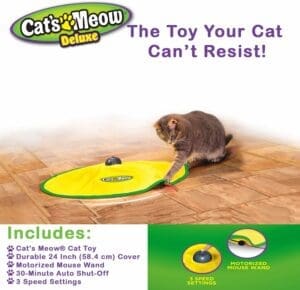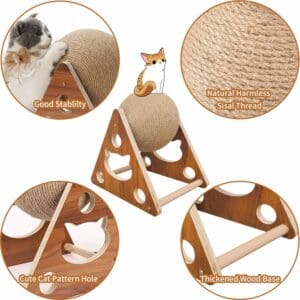If you’ve ever been mesmerized by the captivating gaze of a cat’s eyes, you understand the importance of keeping those beautiful eyes healthy. Cat eye care is crucial in maintaining your feline friend’s overall well-being and ensuring their vision remains sharp. From regular cleaning to monitoring for any signs of irritation or infection, taking a few extra steps to care for your cat’s eyes can make a world of difference. In this article, we will explore the essential tips and practices you need to know to keep your cat’s eyes bright, vibrant, and healthy. So, grab a cup of tea and let’s delve into the fascinating world of cat eye care!
Understanding the Anatomy of a Cat’s Eye
Cats have intricate and fascinating eyes, which are beautifully designed to help them navigate the world. By understanding the anatomy of a cat’s eye, you can gain insight into how their visual system works.
The Structure of a Cat’s Eye
A cat’s eye can be divided into several essential parts, each with its unique function. The outermost layer is the cornea, a transparent dome-shaped structure that helps focus light onto the retina. Behind the cornea is the iris, a pigmented muscular structure that controls the size of the pupil, regulating the amount of light that enters the eye.
Located behind the iris is the lens, a clear structure that further focuses light onto the retina. The retina is the innermost layer of the eye and contains specialized cells called rods and cones, responsible for detecting and processing light. At the back of the eye is the optic nerve, which transmits visual signals from the retina to the brain for interpretation.
The Function of Different Parts of the Eye
Each part of a cat’s eye plays a crucial role in their vision. The cornea and lens work together to focus incoming light onto the retina, allowing cats to perceive their surroundings clearly. The iris adjusts the amount of light entering the eye, helping cats adapt to different lighting conditions.
The rods and cones in the retina enable cats to see in various light levels, including dimmer environments. The information gathered by the rods and cones is then transmitted to the brain through the optic nerve, allowing cats to process and interpret visual stimuli.
Understanding these different parts and their functions can help you appreciate the complexity of your cat’s visual system and the importance of maintaining their eye health.
Common Eye Conditions in Cats
While cats generally have resilient eyes, they can still be prone to certain eye conditions. Familiarizing yourself with these common ailments can help you detect them early and seek appropriate veterinary care.
Conjunctivitis
Conjunctivitis, also known as pink eye, is a common eye condition in cats. It refers to inflammation of the conjunctiva, the thin membrane that covers the white part of the eye and lines the inside of the eyelids. Conjunctivitis can be caused by allergies, infections, or irritants, and can result in redness, discharge, and discomfort.
Corneal Ulcers
Corneal ulcers occur when there is damage or erosion to the cornea, usually caused by scratches or foreign objects. These ulcers can be painful and may result in symptoms such as squinting, excessive tearing, and cloudiness.
Glaucoma
Glaucoma is a condition characterized by increased pressure within the eye, leading to optic nerve damage and potential vision loss. Cats with glaucoma may show symptoms such as dilated pupils, redness, and swelling of the eye, and changes in vision.
Cataracts
Cataracts refer to the clouding of the lens within the eye. They can occur due to aging, trauma, or underlying health conditions. Cats with cataracts may exhibit symptoms such as a cloudy appearance in the eye, changes in eye color, and vision impairment.
Retinal Diseases
Retinal diseases, such as progressive retinal atrophy (PRA), can affect a cat’s ability to see clearly. These conditions involve the degeneration of retinal cells, which can lead to night blindness, changes in pupil size, and impaired vision.
Tear Duct Blockage
Tear duct blockage occurs when the tear drainage system becomes obstructed. This can result in excessive tearing, discharge, and irritation around the eye.
It’s important to note that these are just a few examples of common eye conditions in cats. If you notice any unusual symptoms or changes in your cat’s eyes, it is crucial to consult a veterinarian for an accurate diagnosis and appropriate treatment.
Recognizing Signs of Eye Problems
As a cat owner, you play a vital role in monitoring your cat’s eye health. By recognizing the signs of potential eye problems, you can seek veterinary care promptly and ensure the best possible outcome for your furry friend.
Excessive Tearing
Cats normally produce tears to keep their eyes lubricated and to flush out any foreign substances. However, excessive tearing, also known as epiphora, can indicate an underlying issue. If you notice tears streaming down your cat’s face or constantly damp fur around their eyes, it could be a sign of an eye infection, allergies, or other eye conditions.
Redness or Inflammation
Redness or inflammation around the eyes can be a warning sign of various eye problems. It may indicate conjunctivitis, corneal ulcers, glaucoma, or other infections. If your cat’s eyes appear red or swollen, it is essential to have their eyes examined by a veterinarian.
Cloudiness or Discharge
Cloudiness in the eyes, often accompanied by discharge, can be indicative of cataracts, glaucoma, or infections. If you notice a hazy or opaque appearance in your cat’s eyes, or if there is any abnormal discharge present, it is crucial to seek veterinary attention.
Squinting or Blinking Frequently
Frequent squinting or blinking can indicate discomfort or pain in your cat’s eyes. It may be a response to irritation, injury, or an underlying eye condition. If you observe your cat squinting excessively or blinking frequently, it is important to consult a veterinarian to determine the cause and appropriate treatment.
Changes in Eye Color or Pupil Size
Any noticeable changes in your cat’s eye color or pupil size should be taken seriously. Sudden or gradual changes in the appearance of their eyes, such as a whitish haze, an unevenly shaped pupil, or different-colored irises, can be indicative of underlying health issues. Seeking prompt veterinary care is essential to properly diagnose and treat these conditions.
By regularly observing your cat’s eyes and being attentive to any changes or abnormalities, you can catch potential eye problems early and ensure timely intervention.
Preventive Measures for Cat Eye Care
Just like humans, cats benefit from preventive measures to maintain optimal eye health. By incorporating certain practices into your cat’s daily routine, you can help reduce the risk of eye problems and keep their eyes bright and healthy.
Regular Eye Examinations
Scheduling regular eye examinations with a veterinarian is an essential part of preventive cat eye care. Routine checks allow your veterinarian to detect any early signs of eye conditions, ensuring timely interventions and treatment. They can also provide guidance on proper eye hygiene and care.
Proper Hygiene and Cleaning
Maintaining proper eye hygiene for your cat is crucial to prevent infections and other eye problems. Regularly clean your cat’s face and around their eyes using a soft, damp cloth or a veterinarian-approved eye wipe. Be gentle and avoid applying excessive pressure to the delicate eye area.
Protecting the Eyes from Injury
Preventing eye injuries is an important aspect of cat eye care. Keep your home environment safe by removing potential hazards such as sharp objects or toxic substances that could harm your cat’s eyes. Additionally, consider using protective eyewear for your cat if they are exposed to situations where eye injury is a risk, such as during outdoor adventures or while participating in certain sports.
By following these preventive measures, you can significantly reduce the chances of your cat developing eye problems and ensure they enjoy optimal eye health throughout their life.
Cleaning Your Cat’s Eyes
Regular cleaning of your cat’s eyes is an essential part of their overall eye care routine. It helps to remove dirt, debris, and discharge that can accumulate around the eyes, preventing potential infections and discomfort.
Gathering the Necessary Supplies
Before cleaning your cat’s eyes, gather the necessary supplies. You will need a clean, soft cloth or a veterinarian-approved eye wipe, lukewarm water, and a towel. Make sure the cloth or wipe is lint-free to avoid any particles from getting into your cat’s eyes.
Preparing Your Cat for Eye Cleaning
Prepare your cat for the eye cleaning process by making sure they are calm and in a comfortable environment. Find a quiet, well-lit area where you can easily access your cat’s face without any distractions. Before you begin, reassure your cat with a gentle tone and provide treats as positive reinforcement.
Cleaning Techniques
To clean your cat’s eyes, dampen the cloth or eye wipe with lukewarm water. Gently and carefully wipe around your cat’s eyes, starting from the inner corner and moving outward. Be cautious not to apply excessive pressure or get any water directly into their eyes.
If your cat has excessive discharge or dried-on debris, you can moisten the cloth or wipe with a veterinarian-approved eye cleanser. Follow the product instructions and make sure to keep the eye cleanser from coming into contact with your cat’s eyes.
After cleaning, gently pat your cat’s face dry with a towel. Ensure that their eyes are completely dry to prevent any moisture from causing irritation.
Remember to be patient and gentle during the entire process. If your cat becomes agitated or shows signs of distress, it’s crucial to stop and try again later.
Providing a Balanced Diet for Eye Health
Proper nutrition plays a vital role in maintaining your cat’s overall health, including their eye health. By providing a balanced diet, you can support their eye function and reduce the risk of certain eye conditions.
Importance of a Nutritious Diet
A nutritious diet is the foundation of good health for your cat. It provides essential nutrients that support their bodily functions, including those necessary for optimal eye health. A well-balanced diet can contribute to clear vision, strong retinal health, and a reduced risk of age-related eye conditions.
Essential Nutrients for Eye Health
Several key nutrients are beneficial for your cat’s eye health. These include:
- Vitamin A: Essential for proper vision and overall eye health.
- Omega-3 fatty acids: Support retinal health and reduce the risk of inflammation in the eyes.
- Lutein and zeaxanthin: Antioxidants that promote healthy vision and protect against age-related eye diseases.
Including these nutrients in your cat’s diet can help maintain their eye health and potentially prevent certain eye conditions. Consult with your veterinarian to determine the appropriate amounts and sources of these nutrients for your cat.
Choosing High-Quality Cat Food
Selecting high-quality cat food is essential to ensure your cat receives the necessary nutrients for optimal eye health. Look for reputable brands that prioritize quality ingredients, including those specifically formulated to support eye health.
Read the ingredient list carefully, and avoid products that contain excessive fillers, artificial additives, and low-quality protein sources. Your veterinarian can provide guidance on choosing the best cat food for your furry friend’s needs.
By providing a nutritious diet that supports your cat’s overall health, you can help promote their eye health as well.
Maintaining a Cat-Friendly Environment
Creating a safe and cat-friendly environment is crucial for promoting your cat’s health and well-being, including their eye health. By reducing environmental hazards and ensuring indoor air quality, you can help protect their eyes from potential threats.
Reducing Environmental Hazards
Identifying and eliminating potential hazards from your cat’s environment is essential. Keep small objects, such as toys or household items, that could pose a choking hazard away from their reach. Additionally, secure loose cords and wires to prevent your cat from getting tangled or accidentally scratching their eyes.
Monitoring Indoor Air Quality
Maintaining good indoor air quality is beneficial for your cat’s overall health, including their eyes. Ensure proper ventilation in your home and use air purifiers or filters to remove allergens, pollutants, and irritants that could cause eye irritation or allergies.
Using Cat-Friendly Cleaning Products
When cleaning your home, choose cat-friendly cleaning products that are free from harsh chemicals and irritants. Some cleaning agents can be toxic if ingested or come into contact with your cat’s eyes. Opt for natural or pet-safe cleaning solutions to minimize the risk of eye irritation or allergic reactions.
By creating a safe and cat-friendly environment, you can help protect your cat’s eyes from potential hazards and maintain their overall well-being.
Tips for Handling and Administering Medication
Sometimes, cats may require medication to treat eye conditions or maintain their eye health. Administering medication can be challenging, but with proper techniques and a calm approach, you can make the process easier for both you and your cat.
Administering Eye Drops or Ointments
Administering eye drops or ointments can be intimidating, but it is essential to follow your veterinarian’s instructions to ensure proper treatment. Start by washing your hands thoroughly and preparing the medication as directed. Be sure to check the expiration date and gently shake the bottle or tube before each use.
To apply eye drops or ointments, gently tilt your cat’s head back and hold the bottle or tube close to their eye. Apply a small amount of the medication into the lower eyelid, allowing it to disperse naturally. Avoid touching the bottle or tube directly to your cat’s eye to prevent contamination.
Safely Handling Medications
When handling medications, it is important to be cautious and take necessary safety measures. Store medications in a secure location, away from your cat’s reach. Keep them in their original packaging, clearly labeled, and out of direct sunlight or extreme temperatures that may affect their efficacy.
If you have multiple cats and need to administer different medications, ensure that you keep them separate and labeled correctly to prevent any mix-ups.
Dealing with Cat’s Resistance
Some cats may resist or become anxious during medication administration. To help manage their resistance, gently restrain your cat using a towel or have a second person assist you. Talk to your cat in a soothing tone and offer treats or rewards as positive reinforcement.
If your cat becomes too agitated or distressed, it is important to prioritize their safety and well-being. Consult with your veterinarian for alternative options, such as compounded medications or other methods of administration.
Seeking Veterinary Care and Treatment
While preventive measures and home care routines are essential, there may be instances where veterinary care and treatment are necessary. Understanding when to consult a veterinarian, what diagnostic procedures are available, and the treatment options for cat eye conditions can help you make informed decisions for your cat’s health.
When to Consult a Veterinarian
If you notice any signs of eye problems or changes in your cat’s eyes, it is crucial to seek veterinary care promptly. A veterinarian can thoroughly examine your cat’s eyes, perform necessary tests, and provide an accurate diagnosis to determine the best course of action. Early intervention can help prevent further complications and ensure a higher chance of successful treatment.
Diagnostic Procedures for Eye Problems
To diagnose cat eye conditions, veterinarians may use various diagnostic procedures. These may include a comprehensive eye examination, including visual acuity tests and assessment of ocular structures. Additionally, they may perform specialized tests such as tonometry to measure intraocular pressure or perform ocular ultrasound to evaluate the internal structures of the eye.
Treatment Options for Cat Eye Conditions
The treatment options for cat eye conditions will vary depending on the specific condition and its severity. Common treatment approaches may include prescribing topical medications, such as eye drops or ointments, to alleviate symptoms and promote healing. In some cases, oral medications or surgical interventions may be necessary.
Your veterinarian will work closely with you to develop an appropriate treatment plan for your cat’s specific needs. They will provide guidance on the administration of medications, follow-up care, and any necessary lifestyle adjustments.
Special Considerations for Senior Cats
Senior cats require special attention and care when it comes to their eye health. As they age, they may be at an increased risk of eye diseases and age-related changes. Adapting their eye care regimen and providing necessary support can help ensure their eyes remain healthy and functional.
Age-Related Eye Changes
As cats age, they may experience age-related changes in their eyes. These can include clearer lenses, reduced pupil size, and changes in the appearance of the retina. While these changes are typically a normal part of the aging process, regular monitoring and veterinary check-ups are essential to catch any potential issues early.
Increased Risk of Eye Diseases
Senior cats may be more susceptible to certain eye diseases such as cataracts, glaucoma, or retinal degeneration. It is important to be vigilant in observing any signs of eye problems and seek veterinary care promptly if any abnormalities are detected. Regular eye examinations and preventive measures can help reduce the risk and manage these conditions effectively.
Adapting Eye Care Regimen for Seniors
As cats age, it may be necessary to adapt their eye care regimen. Increase the frequency of eye examinations and screenings, especially if your senior cat has a higher risk of developing eye conditions. Follow your veterinarian’s recommendations regarding any required medications, diet adjustments, or lifestyle modifications to support healthy aging and minimize eye-related issues.
By being proactive in caring for your senior cat’s eyes, you can enhance their quality of life and ensure their ongoing eye health.
In conclusion, understanding the anatomy of a cat’s eye, recognizing signs of eye problems, and taking preventive measures can go a long way in maintaining your cat’s eye health. Through regular eye examinations, proper hygiene, a balanced diet, a cat-friendly environment, and safe handling of medications, you can help protect your cat’s beautiful eyes and ensure they continue to see the world with clarity and comfort. Remember, your veterinarian is your best partner in ensuring your cat’s optimal eye health, so don’t hesitate to seek their advice and assistance when needed. With your love and care, your cat’s eyes will sparkle with health and vitality throughout their lives.

